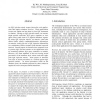Free Online Productivity Tools
i2Speak
i2Symbol
i2OCR
iTex2Img
iWeb2Print
iWeb2Shot
i2Type
iPdf2Split
iPdf2Merge
i2Bopomofo
i2Arabic
i2Style
i2Image
i2PDF
iLatex2Rtf
Sci2ools
ASWEC
2006
IEEE
2006
IEEE
Preventing SQL Injection Attacks in Stored Procedures
An SQL injection attack targets interactive web applications that employ database services. These applications accept user inputs and use them to form SQL statements at runtime. During an SQL injection attack, an attacker might provide malicious SQL query segments as user input which could result in a different database request. By using SQL injection attacks, an attacker could thus obtain and/or modify confidential/sensitive information. An attacker could even use a SQL injection vulnerability as a rudimentary IP/Port scanner of the internal corporate network. Several papers in literature have proposed ways to prevent SQL injection attacks in the application layer by examining dynamic SQL query semantics at runtime. However, very little emphasis is laid on securing stored procedures in the database layer which could also suffer from SQL injection attacks. Some papers in literature even refer to stored procedures as a remedy against SQL injection attacks. As stored procedures reside ...
| Added | 10 Jun 2010 |
| Updated | 10 Jun 2010 |
| Type | Conference |
| Year | 2006 |
| Where | ASWEC |
| Authors | Ke Wei, Muthusrinivasan Muthuprasanna, Suraj Kothari |
Comments (0)

